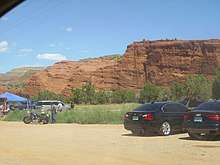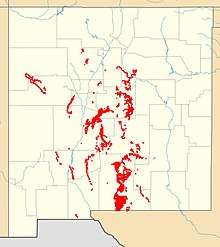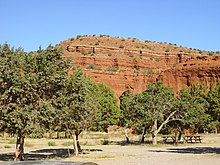Yeso Group
The Yeso Group is a group of geologic formations in New Mexico. It preserves fossils dating back to the Kungurian (lower Permian period.)[1]
| Yeso Group Stratigraphic range: Kungurian | |
|---|---|
 Cliffs of Yeso Group near Canon, New Mexico | |
| Type | Group |
| Sub-units | See text |
| Underlies | Glorieta Sandstone |
| Overlies | Abo Formation |
| Thickness | Up to 309 m (1,014 ft) |
| Lithology | |
| Primary | Sandstone |
| Other | Gypsum |
| Location | |
| Coordinates | 34.1658853°N 106.7465174°W |
| Region | New Mexico |
| Country | United States |
| Type section | |
| Named for | Mesa del Yeso 34.2017512°N 106.7754422°W |
| Named by | W.T. Lee |
| Year defined | 1909 |
 Exposures of Yeso Group in New Mexico | |
Description
The Yeso Group comprises orange eolian sandstones. It is exposed in the mountains and other uplifts bordering the Rio Grande Rift and in the Pecos River valley.[2][3][1] It is present in the subsurface in the Raton Basin.[4]

In the Jemez Mountains, the group consists of massive cross-bedded lower beds (De Chelly Sandstone) and thinner upper beds (San Ysidro Formation) suggesting a more fluvial depositional environment.[5] The Yeso Group is exposed extensively in the Jemez Mountains, but pinches out in the northern Jemez, delineating the northern limit of the dune field from which it arose.[6]
Farther south, the group is divided into the Arroyo de Alamillo and Los Vallos Formations.[7] It transitions from continental to shallow marine in character from north to south, with the lithology changing from eolian and sand sheet deposits in the north to sabkha deposits of gypsum and carbonate rock to the south. [1] Thus the Arroyo de Alamillo Formation is siltstone, ripple-laminated sandstone, and lesser dolomitic limestone, in contrast with the eolian beds of the De Chelly Formation, and the Los Vallos Formation is 42% sandstone, 28% siltstone, and 24% gypsum, in contrast with the thinly bedded sandstone of the San Ysidro Formation. The Los Vallos Formation in turn is divided into the Torres, Cañas and Joyita members.[7]
The group is conformable with both the underlying Abo Formation and the overlying Glorieta Sandstone.[1]
Fossil content
The Yeso Group is largely devoid of fossils. However, continued field work has gradually built up a record of marine microfossils, mostly algae and foraminiferans, trace fossils (including tetrapod footprints), and terrestrial plant fossils. In 2018, a mold of an incomplete, articulated skeleton of a eupelycosaur was discovered in lower Yeso strata.[8] The microfossils date the Yeso Group to the Kungurian.[9]
Tetrapod trackways have been found in the De Chelly Sandstone in the Lucero uplift. These are too poorly preserved for precise classification.[10]
Economic geology
Carbon dioxide was produced from subsurface Yeso Group beds in the Bueyeros, New Mexico field. Production was limited from 1931 to 1980, but increased demand for carbon dioxide for enhanced oil recovery led to construction of pipelines to the Permian Basin. Production totaled 3.3 trillion ft3 by 2018, with an estimated 5 to 10 trillion ft3 still recoverable. Isotope studies suggest the carbon dioxide originated in the earth's mantle and the Yeso Group is merely a reservoir rock. Carbon dioxide accumulates in the Tubb Sandstone and is capped by the Cimarron Anhydrite.[4]
History of investigation
The unit was designated as the Yeso Formation of the (now-abandoned) Manzano Group by W.T. Lee in 1909 for Mesa del Yeso, a small mesa 12 miles northeast of Socorro, New Mexico.[11] Darton redesignated it as a member of the Chupadera Formation in 1922,[12], but Needham and Bates returned it to its original designation as a formation within the Manzano Group in 1943. Needham and Bates also removed the Glorieta Sandstone from the formation.[2]
Kelley and Wood divided the formation into members in 1946, including the lowermost Mesita Blanca Member.[13] Baars pointed out in 1962 that the Meseta Blanca Member is indistinguishable from the De Chelly Sandstone,[3] but this redesignation was not widely accepted until the stratigraphic revisions of Lucas et al. in 2005, which also raised the formation to group rank.[7]
References
- Stanesco 1991, p.M1
- Needham and Bates, 1943
- Baars 1962
- Broadhead 2019
- Wood and Northrop 1946
- Kelley et al. 2006
- Lucas et al. 2005a
- Lucas et al. 2005b
- Vachard et al. 2014
- Voigt and Lucas 2016
- Lee 1909
- Darton 1922
- Kelley and Wood 1946
Bibliography
- Baars, D.L. (1962). "Permian System of Colorado Plateau". American Association of Petroleum Geologists Bulletin. 46 (2): 149–218. doi:10.1306/BC74376F-16BE-11D7-8645000102C1865D.
- Broadhead, Ronald F. (2019). "Carbon Dioxide in the Subsurface of Northeastern New Mexico" (PDF). New Mexico Geological Society Field Conference Series. 70: 101–108. Retrieved 19 May 2020.
- Kelley, S.A.; Lawrence, J.R.; Zeiger, K.E.; Osburn, G.R.; Lucas, S.G. (2006). "Geologic Map of the Arroyo del Agua Quadrangle, Rio Arriba County, New Mexico". New Mexico Bureau of Geology and Mineral Resources Open-File Geologic Map Series. 46 (124).
- Kelley, V.C., and Wood, G.H., Jr., 1946, Geology of the Lucero uplift, Valencia, Socorro, and Bernalillo Counties, New Mexico: U.S. Geological Survey Oil and Gas Investigations Preliminary Map, OM-47, scale 1:63,360, Reprinted with minor revision, 1951
- Lee, W.T., 1909, Stratigraphy of the Manzano group of the Rio Grande Valley, New Mexico: U.S. Geological Survey Bulletin, 389, p. 5-40.
- Lucas, Spencer G.; Krainer, Karl; Colpitts, Robert M., Jr. (2005a), Lucas, S.G.; Zeiger, K.E.; Spielmann, J.A. (eds.), "Abo-Yeso (lower Permian) stratigraphy in central New Mexico", The Permian of Central New Mexico, New Mexico Museum of Natural History and Science Bulletin, 31, pp. 101–117
- Lucas, Spencer G.; Thorpe, Emily D.; Berman, David S.; Rinehart, Larry F.; Santucci, Vincent L.; Henrici, Amy C. (2005b), Lucas, S.G.; Zeiger, K.E.; Spielmann, J.A. (eds.), "Discovery of a tetrapod body fossil in the lower Permian Yeso Group, Central New Mexico", The Permian of Central New Mexico, New Mexico Museum of Natural History and Science Bulletin, 31, pp. 493–498
- Needham, C.E.; Bates, R.L. (1943). "Permian type sections in central New Mexico". Geological Society of America Bulletin. 54 (11): 1653–1667. doi:10.1130/gsab-54-1653.
- Stanesco, John D. (1991). "Sedimentology and Depositional Environments of the Lower Permian Yeso Formation, Northwestern New Mexico" (PDF). U.S. Geological Survey Bulletin (1808).
- Vachard, D; Krainer, K; Lucas, SG (2015). "Late Early Permian (late Leonardian; Kungurian) algae, microproblematica, and smaller foraminifers from the Yeso Group and San Andres Formation (New Mexico; USA)". Palaeontologia Electronica. doi:10.26879/433.
- Voigt, Sebastian; Lucas, Spencer G. (2016). "Permian tetrapod footprints from the Lucero Uplift, central New Mexico" (PDF). New Mexico Geological Society Field Conference Series. 67: 387–395. Retrieved 12 June 2020.
- Wood, G.H.; Northrop, S.A. (1946). "Geology of Nacimiento Mountains, San Pedro Mountain, and adjacent plateaus in parts of Sandoval and Rio Arriba Counties, New Mexico". U.S. Geological Survey Oil and Gas Investigations. Preliminary Map OM-57.